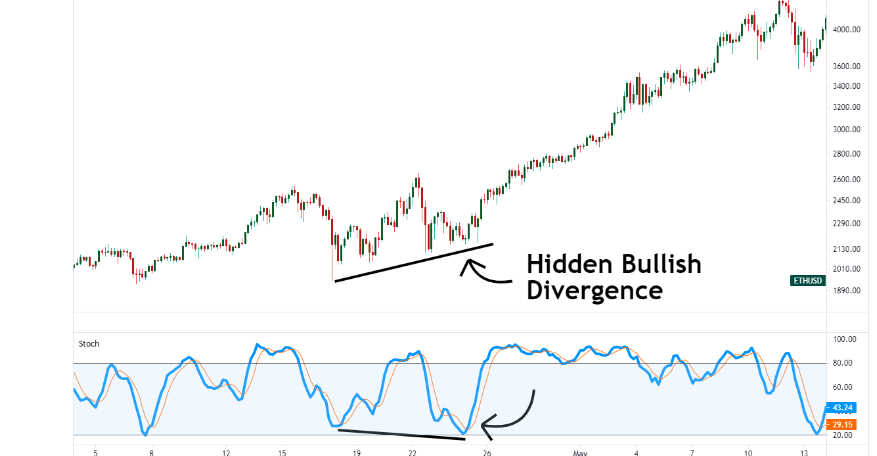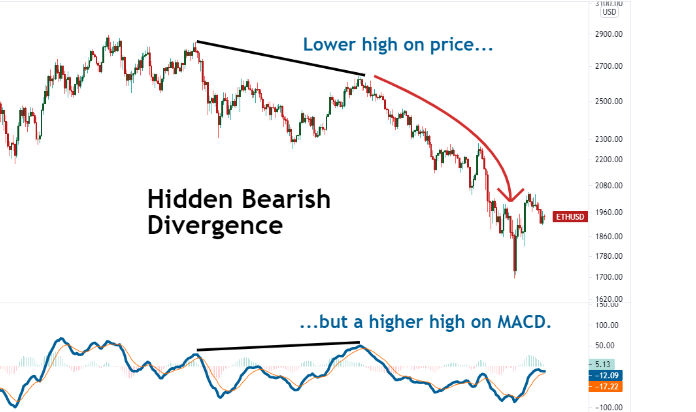Hidden divergence happens when a momentum indicator and underlying asset price move in the opposite direction. There are two types of hidden divergences – hidden bullish divergence and hidden bearish divergence.
At the first glance, hidden divergence is the same as regular divergence but it is not.
While regular divergence can notify you ahead of time of a possible reversal, or change in the price direction, hidden divergence can notify you ahead of time when a trend is set to continue.
What Is Hidden Divergence?
Like regular divergence, the hidden divergence also is categorized as bullish hidden divergence and bearish hidden divergence.
Bullish hidden divergence is formed when the price of a security makes a higher low, while the indicator makes a lower low.
Bullish Hidden Divergence
Bullish divergence happens during a correction of an uptrend when a security price makes a higher low, But the momentum oscillator makes a lower low. This usually indicates the uptrend continuation.

Bearish Hidden Divergence
Bearish hidden divergence is the opposite of bullish hidden divergence. An asset price makes a lower high, but the momentum oscillator makes a higher high. This indicates a downtrend continuation.

How Is Hidden Divergence Different From Regular Divergence?
Hidden divergence is different from regular divergence due to the location of the pattern. While regular divergence occurs at end of the trend and indicates the trend reversal, hidden divergence tends to appear within an existing trend. It signals the end of a consolidation phase within the larger trend. We call it “hidden” because it isn’t obvious to the untrained eye.
Above, we can see a strong uptrend within Bitcoin’s price. There are two instances of bullish hidden divergence in the middle of this uptrend. The first appears on February 4, 2021. The RSI indicator creates a lower low, while Bitcoin’s price creates a higher low. This signals the end of the small consolidation as Bitcoin rallies higher.
Then, between February 10 and February 14, another consolidation occurs. Again, RSI is forming a lower low, while Bitcoin’s price creates a higher low. This hidden divergence signals the end of that small correction and Bitcoin rallies further.
Identifying and Trading Hidden Divergence
To find signs of hidden divergence and the possible continuation of a trend, you first need to make use of a momentum oscillator to identify that a trend is going on. After this, you should look for a trend consolidation period where hidden divergence patterns can appear.
Common indicators for spotting hidden divergences are the Relative Strength Index, the stochastic indicator, and the Moving Average Convergence Divergence. However, you can use almost all momentum oscillators to find hidden divergence.
RSI indicator to identify Hidden Divergences
Here is an example of using RSI for identifying hidden divergence.
MACD indicator to identify Hidden Divergences
Here is an example of hidden divergence identified with MACD.
Stochastic oscillator to identify hidden divergence
Here is an example of hidden divergence identified with a stochastic oscillator.
You should remember that divergences should not be traded as a signal, they should be traded as a confirmation of the main signal from other technical indicators.
You should use any trend indicator like the moving average to know the primary trend and get confirmation from divergence to enter a trade.
How Reliable Is Hidden Divergence?
Although hidden divergence is a powerful pattern indicating a continuation of a market’s movement, it cannot be used in isolation. New traders should focus on regular divergence before incorporating hidden divergence into their trading practices.
Remember that hidden divergence does not always result in a trend continuation. According to one analyst, hidden divergence patterns sometimes are meaningless and cannot predict major price action changes.
By using two or three indicators simultaneously, traders may form a more robust strategy to trade.
Sometimes, when using two or more different indicators, the indicator signals may differ from one another.
In such cases, it’s best to take a step back and examine whether the conflicting signals are obvious and strong. If they are, it’s a good idea to stay away from the asset for a while.
Tips on using the Hidden Divergences
To reduce false signals, hidden divergences should be used on longer timeframes. With longer time frames, the market does not move as fast, and it’s easier to determine the patterns of highs and lows. The drawback is that longer time frames result in fewer trades and fewer divergences.
Can a regular divergence and a hidden divergence occur at the same time?
In shorter time frames, there is a possibility that bearish regular divergence and bullish hidden divergence (or bullish regular divergence and bearish hidden divergence) may appear at the same time. In such cases, if there are no other strong entry signals, a trader should avoid entering the market for a while.
Remember that regular divergence signifies a change in the trend’s direction and should be traded at the end of the trend, while hidden divergence suggests strength coming into the trend and should be traded at the beginning of the trend. When trading divergence, there should be obvious ups or downs on the price chart for an existing trend.
Conclusion
Bullish and bearish hidden divergences are very powerful patterns seen at the end of consolidation. They signal a continuation of the original trend.
These patterns are frequently found within Bitcoin, Ethereum, and other crypto markets, making them easy to learn.
However, spotting them in real time is challenging. Additionally, if hidden divergence is discovered late in the trend, the trade tends to be less rewarding.
The key to success in trading hidden divergence is to filter your trades in the direction of the larger trend.


